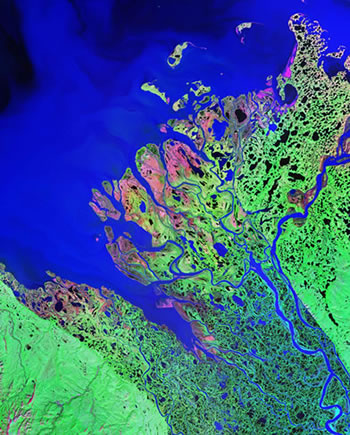Frozen peatlands occur today in the southern fringe of the discontinuous permafrost zone at relatively warm ground temperatures (> 0.5°C). Permafrost likely formed when slightly colder climatic conditions prevailed in the northern hemisphere during the Little Ice Age. Between 1550 and 1850 AD, temperatures were about 1°C cooler than present and permafrost occurred farther south than it does today. Much of this permafrost has generally degraded in response to warming but has been preserved in some areas due to the insulating properties of the thick peat cover.

(NASA Landsat / USGS).
Evidence also exists for climate-induced changes to permafrost response during the last several decades to a century. During the last 100 years, air temperatures in the Mackenzie District (western Arctic, Figure 1) have warmed by about 1.5°C. This warming has caused an increase in permafrost temperatures in the Yukon and western N.W.T. In Manitoba, permafrost continues to degrade in the southern fringe of the permafrost region especially where there is no surface peat layer. In the eastern Arctic, however, recent cooling and aggradation (growth) of permafrost has occurred. Air temperature records for northern Quebec, show a decrease in temperature between 1947 and 1992 ranging from .02 to .03°C per year which has been accompanied by a cooling of the upper 20 m of permafrost between 1988-1993 (Smith, Burgess & Heginbottom, 2001).
References
Permafrost Links
Material for this section was provided by Sharon Smith and Margo Burgess, Geological Survey of Canada.
